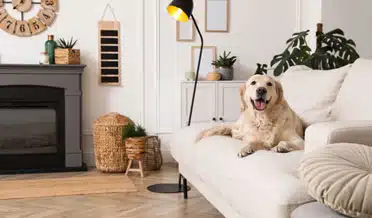Indoor Air Quality: Pet Friendly HVAC System
Is Your HVAC System Pet Friendly and Provides Good Indoor Air Quality?
We Americans love our pets! Did you know there are approximately 140 million homes and approximately 148 million dogs and cats in the U.S.? For the most part, we take good care of our pets. However, our pets can put stress on the heating and cooling systems. Here are some things you can do to make pets and HVAC systems more compatible and provide good Indoor Air Quality.
Every day, family members lose hair and skin, the source of most of the dust in the home. Some pets shed less than others, but dogs and cats also contribute to the hair and dander in your home. These additional airborne particles move around, collect on surfaces, and get caught in the ventilation system in your home. This additional air pollution can irritate sinuses, trigger asthma or allergies, and cause respiratory problems.
The ventilation portion of your HVAC system, like human lungs, is designed to remove airborne particles and provide improved Indoor Air Quality. The number of airborne particles will need to be removed to reduce the threat of respiratory illnesses. The place to start is the air filter.
Air Filters
With every heating or cooling cycle, the filter is trapping dust and dander, preventing them from recirculating with the next cycle. When too many particles get trapped, the filter clogs and restricts airflow; the result is stress, as was mentioned earlier. Under normal circumstances, the recommendation is to change the filter every three months, but with shedding pets, you might need to change them more often—perhaps every 6 to 8 weeks.
The type of lifter can make a difference. Pleated filters have more surface area than regular flat filters. Filters are given a minimum efficiency reporting value or MERV rating. The rating measures the percentage of particles the filter can remove—higher numbers = more particles removed. A MERV rating between 8 and 11 will remove most hair and dander. Filters with electrostatic properties will also attract hair with ease.
Enhanced Household Cleaning
Does cleaning your house help your HVAC system? Certainly. All that dust, hair, and dander becomes airborne and then gravity takes over. Dust falls everywhere—on floors, furniture, and everything else. Carefully dusting, mopping, and vacuuming will remove a large amount of hair and dander before it gets to the air filter. Reducing clutter removes objects dust can cling to. Make sure to clean the supply vents on the floor and the cold air returns on the walls.
Clean Your Ductwork
Hair and dander that gets past your air filter collect inside of the supply and return ducts that network throughout the house. Since the amount of dust increases with pets, the amount that collects inside the ducts is also larger. Under normal conditions duct cleaning is recommended every 3 to 5 years; with pets, you should schedule a duct cleaning more often—say every three years.
Schedule HVAC Service
To ensure your entire system stays clean, it is important to complete preventative maintenance inspections regularly; an annual visit is recommended. Hair and dander that gets beyond the air filter can also enter the electrical control and the evaporator chamber. Dust decreases the energy efficiency of your system, so it is important to clean it away.
Speaking of schedules, remember your pet when you program your thermostat. A programmable or Smart thermostat is often used to save money by altering the temperature setting. While this might save some money, it will also put stress on pets.
Let us help with your Indoor Air Quality questions!
Schedule your free Indoor Air Quality consultation by calling AllCool AC & Heating at 281-238-9292 or contact us via email.
